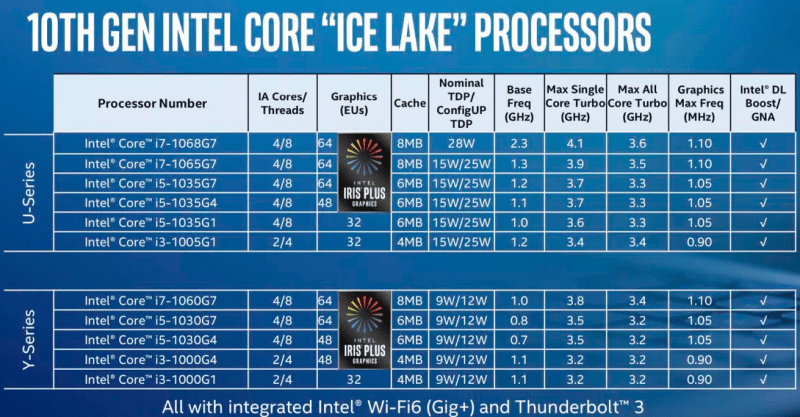By Rick Merritt, Silicon Valley bureau chief, EE Times
Early reviews of Intel’s first processors made in its much-delayed 10-nm node were mixed. A handful of reviewers praised their integrated graphics but said CPU improvements were modest at best.
The 11 members of the notebook IC family, code-named Ice Lake, pack Wi-Fi 6 and Thunderbolt 3 support along with up to 64 GPU execution engines, more than twice the number on current chips. They will run at 9-28 W compared to about 35 W for today’s 14-nm parts.
Intel said the CPU in the chips will deliver an 18% improvement in instructions per clock. However, the chips generally run at lower clock frequencies than Intel’s current 14-nm notebook chips.
Ice Lake supports instructions, first introduced on its Xeon server processors, to accelerate deep learning inference. It also includes a so-called Gaussian and Neural Accelerator used for voice processing and noise reduction.

A significantly bolstered graphics core is the highlight of Intel’s 10-nm Ice Lake family. (Image: Intel)
“These CPU numbers are nothing to stoke a burning desire to go out and buy a new laptop…[but the chip offers a] more dramatic boost in onboard graphics,” said a PCMag review.
“If it were not for the vast increase in memory speed, moving from LPDDR3-2133 to LPDDR4X-3733, one might have predicted that the Core i7-1065G7 Ice Lake processor and the Core i7-8565U Whisky Lake processor would have performed equally…the one area where Ice Lake excels in is graphics,” agreed a review from Anandtech.
The growth of Intel’s notebook processors “has been meaningfully better than global IC growth (excluding memory) in each of the last four quarters,” David Wong, analyst with Nomura/Instanet, wrote in a research report. “We think ramping Ice Lake shipments are likely to drive Intel’s notebook processor sales growth in the September and December 2019 quarters,” he added.
The company remains on track to ship in notebooks by the end of the year. Originally, Intel aimed to ship its first 10-nm notebook chips in late 2018.
The article originally published at sister publication EE Times.
Advertisement
Learn more about Electronic Products Magazine





